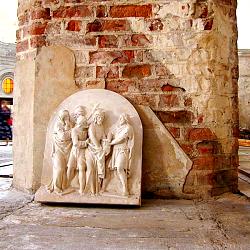Hill of Crosses - Kryziu
kalnas
|
The Hill of Crosses near Siaulai is a memorial to the pain over those who gave their lives
in the fight against Communism, in the 1863 revolution and in the Partisan war between 1944 and 1956. It all started
when three graves were found after people killed in the 1863 revolution and crosses erected over them. It’s been
adding ever since. The hill has about a million crosses, but as visitors continue to hang their own small crosses
on the larger ones it is quite impossible to estimate the real number.
A strange tale is told about the hill: In the sixties the Communists wanted to erase the hill in the typically
Communist way, by running it over with a bulldozer. No one wanted to do it, but finally one man volunteered and
ran down all the crosses. The man died a mysterious death soon after, and the man who ordered the destruction saw
his children roll into a lake and drown, locked inside a car. He himself died soon after. People put all the crosses
up again in the nights and no one touched the hill any more. |
|
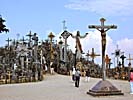
|
This fantastic, almost surrealistic sight greets you at the entrance to the Hill of Crosses. The hill has spread
and the main entrance is now surrounded by crosses on all sides. |

|
An enormous statue of Christ leads you on the man path, towards the Madonna. |

|
You walk up the steps and your head twists and turns to see all the crosses. Still, you don’t understand. |
Special Crosses and Memorials
|
|
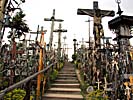
|
Some distance into the jumble the enormous amounts and the richness of styles take you in. |

|
There are old and new crosses, crosses from today and from the 19:th century. |

|
An indescribable jumble. |
|
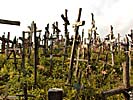
|
Department of ancient crosses, perhaps over a hundred years. |
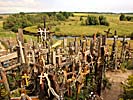
|
An indescribable jumble. |

|
There are paths going everywhere so you can walk around and see all parts of the hill. |
|

|
An indescribable jumble. |
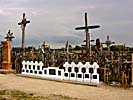
|
Ten white crosses. If anyone knows the symbolics, please tell me. |
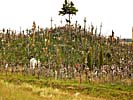
|
From the Papal chapel the hill looks like this. It continues far to the left and right outside the picture. |
|

|
A lone, small cross, perhaps a foot high, which does not contain any less loss and pain then the big ones. Perhaps
the donor was poor? |

|
Blue and yellow crosses, almost Swedish. |
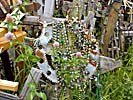
|
All figures are hung full of innumerable smaller crosses and rosaries, left by people wanting to show their respect
to those who gave their lives for the fatherland. |
|

|
The Lithuanian art of sculpture is very special, and here are many examples. Just look at the wrinkles of sorrow
in the forehead of this one. |
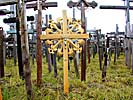
|
Some crosses are very artful. This is a Lithuanian sun-cross, a mixture of pagan and Christian tradition. |

|
Little “chapels” for burning incense, filled with pictures and rosaries. |
|

|
Another “house”, also brimming with memories. |

|
The ultimate in uniqueness must be a brick cross. Perhaps built by a brick-layer, or in memory of a brick-layer? |
The Visit of Pope John Paul II in 1993
|
|

|
The Pope gave his own cross to the Hill at his visit. It is placed in front of the entrance. Yes, I have fixed
the colours. |
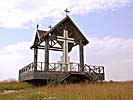
|
The chapel is some distance away from the Hill. It was erected for the Pope, for holding the mass. |
Kaunas, 1992
|
| The Soviet power banned all religious practice and used the churches to other things. |
|
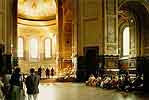
|
We happened to “come by” a wedding in a church in Kaunas in 1992. As you can see from the picture, the church has
not been restored and it is evident that the Red Army had used it for target practice. |
The Desecrated Bernadine Monastery in Vilnius, 2004
|
| The Bernadine Monastery is built together with St. Anne’s Church in Vilnius. St. Anne’s
escaped completely unharmed, whereas the monastery is utterly destroyed inside Rumour has it that the students
at an art college in Vilnius got the monastery as practise space in the Communist days, to practise painting frescoes,
which is why it looks terrible inside. I guess they used something else than brushes for painting, such as sledgehammers.
The monks had been deported long ago. |
|

|
The exterior is without flaw |

|
The belfry is nice. Yes, it’s fine on the outside. |
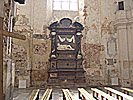
|
A black altar with lots of broken walls around. |
|
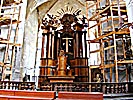
|
But inside, oh the misery. Everything that once was, has been rebuilt in wood, to enable... |
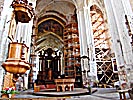
|
you to see what it once looked like, awaiting proper restoration. |
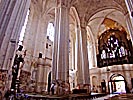
|
The organs seem quite “toothless”. Some of the pipes are probably stolen. |
|
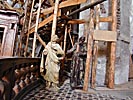
|
Two statues hidden away and rescued. |
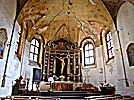
|
A cracked side chapel with pieces of paintings in the roof. |
We should be very grateful for Vladas Drema’s book “Vilnius Lost” (Dinges Vilnius) from which all restorers can
get pictures and drawings of all the churches destroyed by the Communists. |
|
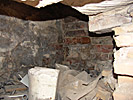
|
The hacked large holes in the wall. What can you see inside? Nothing, actually. |
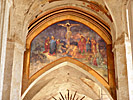
|
They have uncovered some paintings underneath the white, although this was black from age. |

|
I have helped them a little with Photoshop. It is some sort of cartoon with text balloons. |
|

|
The ceiling is being cleaned. |
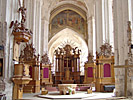
|
In 2006 the work had progressed. The many scaffolds... |
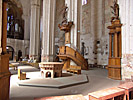
|
were removed and work had proceeded to finishing the walls. |
The Desecrated Virgin Mary’s Church in Vilnius
|
| In Virgin Mary’s Church restoration work was going on as before without much difference
visible inside. Walking by, one could hear the restorers banging away like poltergeists inside the walls. Small
fragments of the original decorations were left. The Soviets hadn’t managed to destroy it all, but in all places
where religious figures had been, terrible holes were gaping in the walls. It wall just as much about terror as
about erasing the past. |
|

|
Virgin Mary’s Church beside the Franciscan Monastery was manhandled by the Communists. The exterior is decayed,
with plaster coming off. Restoration has begun. |

|
The main aisle looks bad. There is almost nothing left of decorations and ceiling paintings. The restorers will
have a hard job. |

|
Only one chapel was somewhat restored in 2001 and could be used. |
|
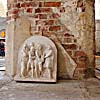
|
There are loose parts leaning against walls everywhere. This is a relief that escaped the destruction in some way. |

|
The holy family looking down at the misery, in the form of restorers’ sketches. |
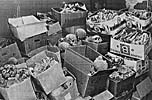
|
A horrible picture of what was dug up in the church during renovation: lots of human bones, remains of murdered
people. |
|
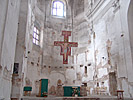
|
The San Damiano Cross, showing that this is a Capuchin church, hangs above the altar. |

|
On one pillar I found some sort of St. George and the dragon. Slightly faded, but I helped out a little. |

|
See what a restorer can do with a shovel and some paint. |
The Desecrated Missionaries Church in Vilnius, 2005
|
| The Missionaries Church stands where Rasu Street from the airport turns into Vilnius on
Subacius Street. You always pass it riding the airport bus. According to my source it should be restored inside,
but the doors are nailed shut. |
|

|
It is reported to be very beautiful inside. It was restored in the 1980’s but how much is unknown. |

|
Old man with book, statue on the front. Moses perhaps? |
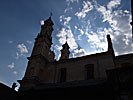 |
Nice silhouette, actually the best picture of this church. |
|

|
Viewed from the narrow part of Subaciaus Street. The drug store building is to the left. |

|
The entrance to the drug store, joined with the church. The church is also conjoined to an old monastery, later
turned into hospital. The hygiene was so bad that that he Communists liked it a lot. It’s closed now. There seems
to be a mental health ward left (as observed from the outside). |
The Desecrated Augustine Church in Vilnius, 2005
|
| The Augustine Church on Saviciaus Street in the Old Town looked a junk yard for along time.
The fence was nailed shut and the yard was full of planks. In 2005 something started to happen. It was possible
to enter the yard. Watch this space for news! |
|

|
This church is so big it was difficult to get on one picture with a 28-mm lens. The yard is simply too small. The
cars belong to the neighbours. |
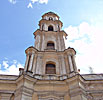
|
It looks like a four-stage rocket and has a good chance of becoming an Old town beacon. |
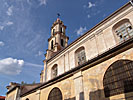
|
You can’t get inside and have a look. The door is mailed with giant medieval nails and the windows covered with
black material and steel bars. |
|

|
It will look grand when it’s finished. It is amazingly high. It seems to be built for the visual effect. |

|
It is badly dented, but something is about to happen. |
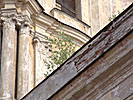 |
Bushes are growing on the roof. There’s a lot to do here. |
Bullet Holes in a Wall - Memories of a Failed Coup
|
| After having freed themselves from the Soviet power by democratic means, Lithuania was hit
by a coup d’Etat in March 1990, in the true Perestroika spirit. The Nobel Peace Prize laureate, president Michail
Gorbachev sent tanks into Vilnius to retake the country - his granary - for all the free food. The coup failed
miserably, mostly because of the people's determination and will to use their bodies defending the city's most
important points. Many had to give up their lives, run over by tanks or shot with machine guns. The Soviets took
over the city's largest newspaper printer, Spaudos Rumai,
the Printing Palace. A spray of bullets hit the facade. |
| Maybe the enthusiasm over freedom has waned. In 2006 the bullet holes were covered by an advertisment. Advertisement
money unfortunately weighs heavier than history. The following images are historical. |
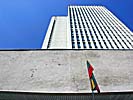
|
Guarded by a Lithuanian flag, the bullet spray sits in the facade over the entrance to the printer's. |
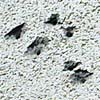
|
They may seem insignificant, the pieces of lead stuck in the plaster, but not for those guarding the entrance,
with their bodies as the only means of resistance. |
|
